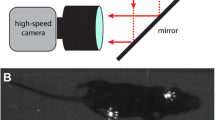Abstract
Stereotyped behavior in rats, consisting of compulsive, repetitive sniffing and gnawing, caused by high doses of amphetamine-like psychostimulants, may serve as an animal model for psychosis. Previous methods for measuring behavioral stereotypies of this kind have required continuous observation and rating of the behaviors or semiquantitative techniques that fail to produce a continuous record of the behaviors. The present paper describes a simple automated method that provides a continuous quantitative record of the specific gnawing behavior induced in rats by methylphenidate, an amphetamine-like psychostimulant. The apparatus described and the test procedures developed are compatible with a wide variety of common counters and recorders.
Similar content being viewed by others
References
Breese GR, Cooper BR, Hollister AS (1975) Involvement of brain monoamines in the stimulant and paradoxical inhibitory effects of methylphenidate. Psychopharmacologia 44:5–10
Bryan KS, Ellison G (1975) Cholinergic modulation of an opposed effect of d-amphetamine and methylphenidate on the rearing response. Psychopharmacologia 43:169–173
Davis K, Hollister LE, Tepper J (1978) Cholinergic inhibition of methylphenidate-induced stereotypy: Oxytremorine. Psychopharmacology 56:1–4
Hughes RN, Greig AM (1976) Effects of caffeine, methamphetamine and methylphenidate on reactions to novelty and activity in rats. Neuropharmacology 15:673–676
Janowsky DS, El-Yousef MK, Davis JM, Sekerke HJ (1972) Cholinergic antagonism of methylphenidate-induced stereotyped behavior. Psychopharmacologia 27:295–303
Janowsky DS, El-Yousef MK, Davis JM, Sekerke HJ (1973) Provocation of schizophrenic symptoms by intravenous administration of methylphenidate. Arch Gen Psychiatry 28:185–191
Makamjuola ROA, Hill G, Maben I, Dow RC, Ashcroft GW (1977) An automated method for studying exploratory and sterotyped behavior in rats. Psychopharmacology 52:271–277
Pedersen V, Christensen AV (1972) Antagonism of methylphenidateinduced stereotyped gnawing in mice. Acta Pharmacol Toxicol 31:488–496
Quinton R, Halliwell G (1963) Effects of α-methyl dopa and dopa on the amphetamine excitatory response in reserpinized rats. Nature 200:178–179
Randrup A, Munkvad I (1967) Behavioral stereotypies induced by pharmacological agents. Pharmakopsychiatr Neuropsychopharmacol 1:18–26
Scheel-Kruger J (1971) Comparative studies of various amphetamine analogues demonstrating different interactions with the metabolism of chatecholamines in brain. Eur J Pharmacol 14:47–59
Author information
Authors and Affiliations
Rights and permissions
About this article
Cite this article
Moss, D.E., McMaster, S.B., Castañeda, E. et al. An automated method for studying stereotyped gnawing. Psychopharmacology 69, 267–269 (1980). https://doi.org/10.1007/BF00433093
Received:
Accepted:
Issue Date:
DOI: https://doi.org/10.1007/BF00433093




